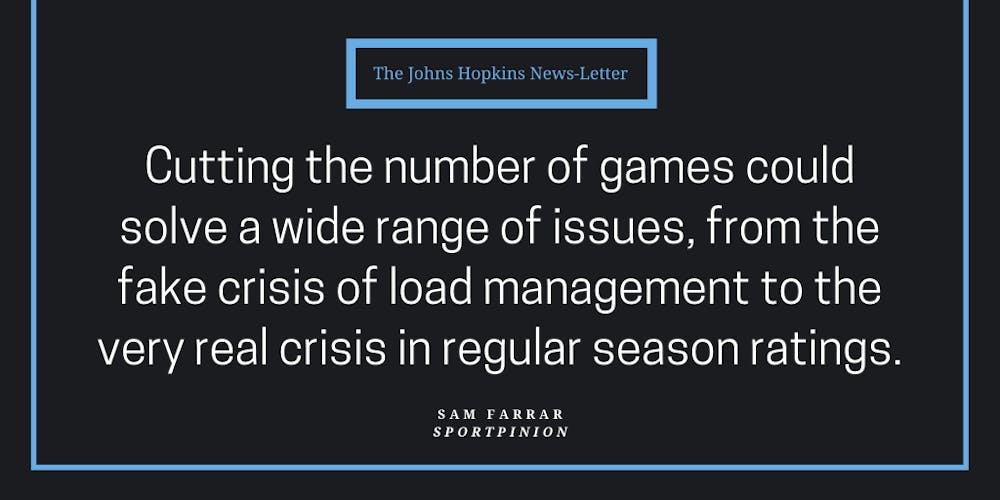
Roughly a quarter-way through the National Basketball Association (NBA) season, three headlines have been circulating around the basketball world.
First, and the most divisive, is the discussion around load management. Through 21 games, Kawhi Leonard has missed six, for purely injury-prevention purposes. That is roughly on pace to match his last season, where he missed 22 games in the 82-game regular season. Stars are seemingly sitting more games than they ever have (whether they actually are is debatable), and that has generated a lot of controversy.
There are two camps here, seemingly equally divided. One group recognizes that Leonard has a degenerative quad condition that has required rest for years, and the load of a full season and playoffs is not sustainable long-term for players’ health. The other group is boomers who are upset that they spend $200 a year of their $100,000 salary (from a job their father gave them in 1978 after graduating from a college that cost a buck fifty a year with a 2.0 — I should stop) on NBA league passes just to have the best player on their third favorite team miss one in four games.
Beyond load management, the Sports Business Journal reported a significant drop in broadcast ratings on Monday compared to this time last year. National channels, such as ESPN and TNT have seen roughly a 20 percent drop in viewership, and regional sports channels have seen a 13 percent drop. Some blame this on injuries sidelining some of the biggest stars in the league, such as Steph Curry and Kevin Durant. Others say it is because NBA games are primarily played on cable channels (as opposed to broadcast), which are rapidly losing subscribers.
The final big news story of this new season is a series of rumors regarding possible changes to the structure of the NBA’s season. This includes shortening the regular season from 82 to 78 games, and creating a mid-season tournament. Moreover, the post-season would begin with a play-in tournament for the lower seeds and would get re-seeded in the semi-finals.
In short, there is a problem with the NBA schedule. Player’s bodies can’t hold up in the long run, fans are watching the regular season less and less, and the league recognizes change needs to happen. But their changes don’t go far enough. To solve its schedule problem, the NBA should look to its rival league, the National Football League (NFL).
Yes, this may be the first time someone has ever pointed to the NFL as a good example of anything. I have many, many problems with the NFL, but man, they got one thing right.
On one hand, teams play just one game a week because the physical nature of the sport necessitates a lengthy recovery period.
On the other, the one-game-a-week model leaves so much space for storylines to grow and hype to build. Those six days between standard Sunday games aren’t empty space; they’re filled with analysis, theory-crafting and predictions. And when a player proves you wrong, the six days that built up to that moment make it all the more special.
Now, I’m not advocating for a 16-game NBA season, but shaving four games from an 82-game season does as close to nothing as doing something can. In fact, looking at overall games is not the way to decide the ideal length of schedule. Rather, the answer lies in the rate of games. Look again at the NFL. The three days a week in which football is aired feel like holidays. Thursday Night Football (TNF) is usually a less popular matchup, but it is just enough to satiate our football hunger (granted, TNF is very dangerous for players and should probably not exist). Then, Sunday is the big day, the day you wake up early to cook for, the day you clear to watch football from dawn till dusk. Then, Monday Night Football is the New Year’s Eve to a new week of football drama and narratives.
Then there is the NBA, which airs games pretty much every day for the entire season. That doesn’t leave any space to build the character of the season in the same way the NFL can. Reducing the number of games in the season wouldn’t take content away, it would just balance the on-the-court content with the theater that is necessary to support a sports league.
As of now, the NBA season runs 176 days. In the current season structure, that means each week averages roughly 49 games across the league. That’s just too many to cover.
Say each team’s season was reduced from 82 to 50 games, for example. That’s only 30 games a week across the league, exactly enough for each team to have one home and one away game a week.
On the surface, this proposal seems like it would significantly cut down on the content we get from the NBA, but I say it would do the opposite. Part of the reason the NBA seems so top-heavy is that some teams, like my beloved Hornets, are ignored simply due to the basketball world’s limited bandwidth. A shorter season is why the Bengals get more coverage than some mid-tier NBA teams.
Overall, the rumors surrounding season changes in the NBA are promising, but they don’t go anywhere near far enough. Cutting the number of games could solve a wide range of issues, from the fake crisis of load management to the very real crisis in regular season ratings.





